LEARNING OBJECTIVES
LEARNING OBJECTIVES
- Understand the different types of pronouns.
- Recognize pronoun antecedents.
- Make sure pronouns and antecedents are relatively close together and match in person, number, gender, and human versus nonhuman state.
Pronouns can be somewhat confusing, but they can help make your use of language smoother and more compact. For example, if your name were Pete Rando, you could write, “Pete Rando is going back to wait to go back to Pete Rando’s camper until Pete Rando’s friends have seen the sunset at the Grand Canyon.” Or you could say, “I’m going to wait to go back to my camper until my friends have seen the sunset at the Grand Canyon.” A first step in understanding how and when to use pronouns properly is having an overall picture of pronouns. The following video explains pronouns and antecedents:
<
Study the following table for an overview of the different types of pronouns. Note that some pronouns, such as possessive pronouns and interrogative pronouns, show up on more than one list.
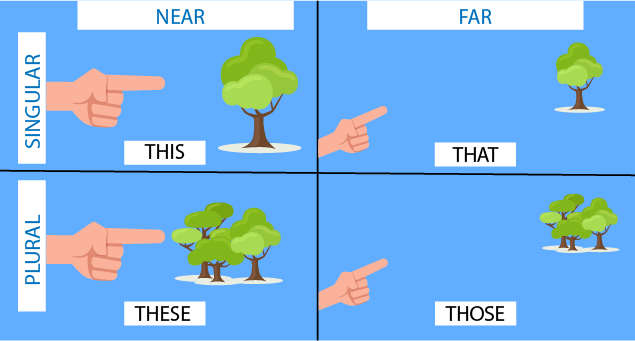
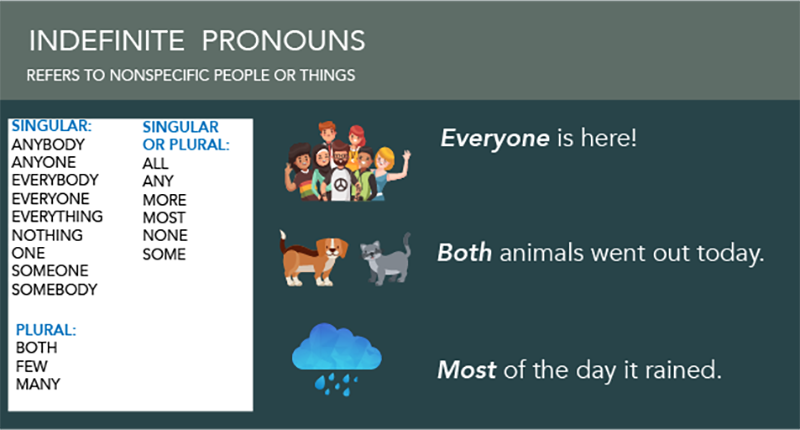
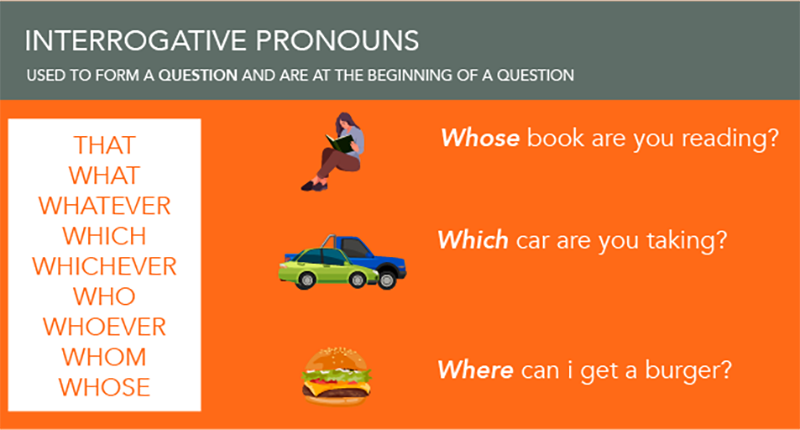
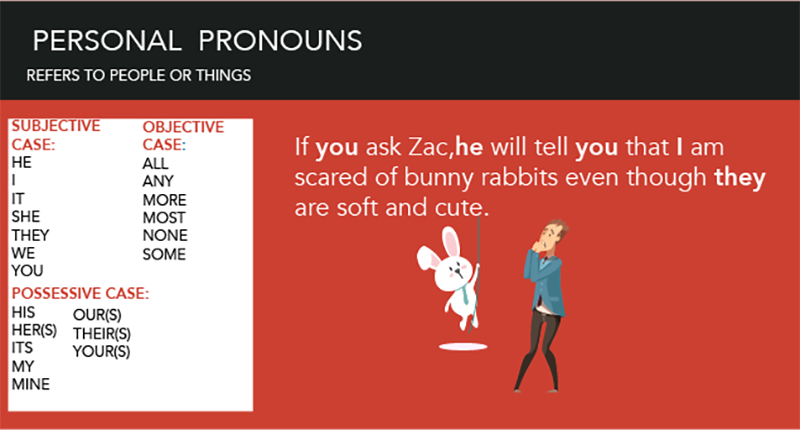
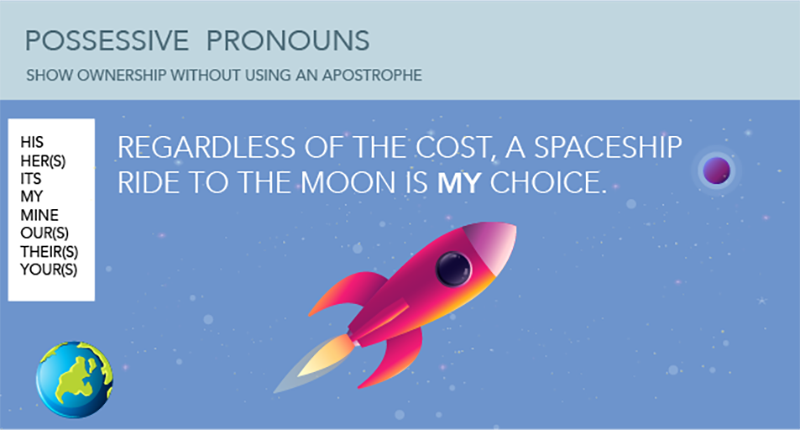
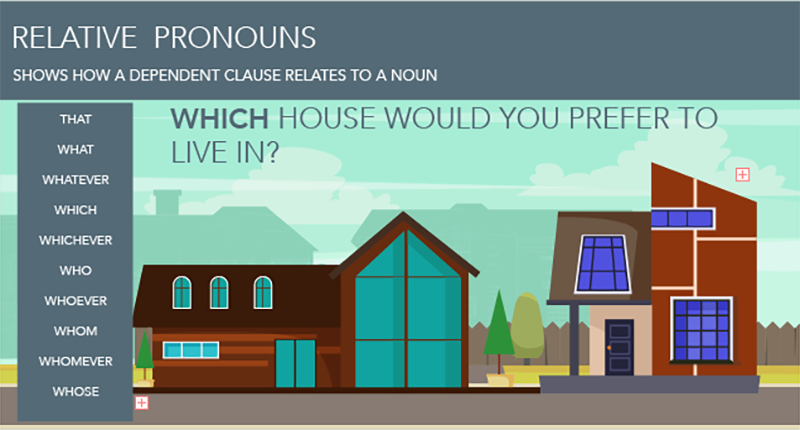
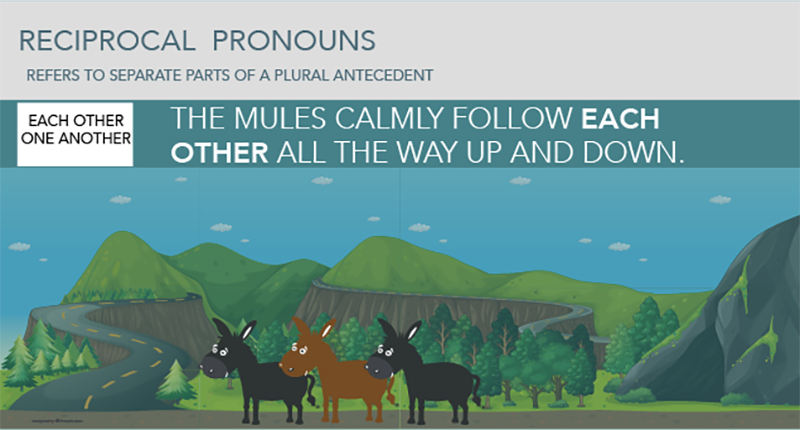
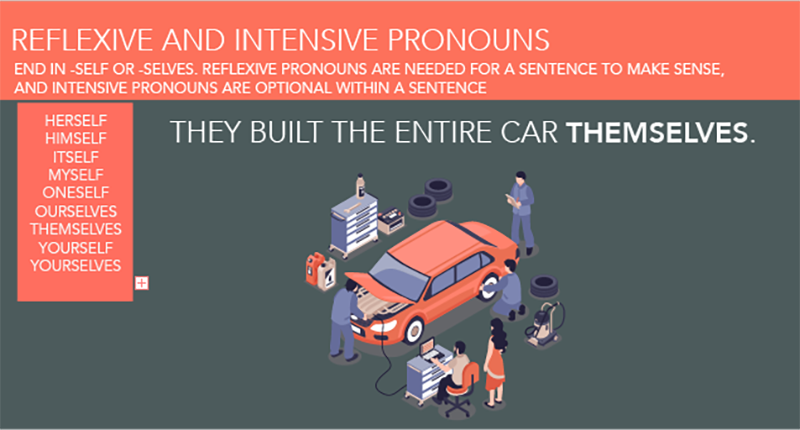
Another step in properly using pronouns is to recognize a pronoun’s antecedent, which is the noun or pronoun to which a pronoun refers, and make sure the pronoun and antecedent match in number, person, gender, and human versus nonhuman state. Also, to make the antecedent-pronoun match clear, the pronoun should follow relatively soon after the antecedent, and no other possible antecedent should fall between the antecedent and the pronoun.
Figure G4.9: Compound Antecedent Guidelines
|
Antecedent Situations |
Example in a Sentence |
Pronoun Antecedent Guidelines |
|
Compound antecedents |
Joey and Hannah spent the weekend with their parents at the Grand Teton National Park. |
As an antecedent, “Joey and Hannah” is plural, non-gender-specific, human, and third person, so the pronoun must match. Hence their works, but, for example, our, his, her, and them would not work. |
Figure G4.10: Indefinite Pronoun Antecedent Guidelines
|
Antecedent Situations |
Example in a Sentence |
Pronoun Antecedent Guidelines |
|
Indefinite pronouns that act as an antecedent for other pronouns |
Some of the moose left their footprints in our campsite. |
Since “of the moose” is a nonessential phrase, the antecedent for their is some. The pronoun some can be singular or plural, so it agrees with their, which is plural. |
Figure G4.11: Collective Noun Antecedent Guidelines
|
Antecedent Situations |
Example in a Sentence |
Pronoun Antecedent Guidelines |
|
Collective noun antecedents |
The Teton Range is quite regal as it protrudes upwards nearly seven thousand feet. |
Teton Range is a collective noun and, therefore, is considered single (multiple mountains within the range, but only one range). It is nonhuman, so it agrees with it. Collective nouns are sometimes an exception to the human versus nonhuman guideline since a noun, such as “crew” or “audience,” can match to the pronoun its. |
Figure G4.12: Collective Noun Antecedent Guidelines
|
Antecedent Situations |
Example in a Sentence |
Pronoun Antecedent Guidelines |
|
Antecedents and gender-biased pronouns |
Everyone should make his or her own choice about hike lengths. Or Everyone should make their own choice abut hike lengths. |
Years ago, acceptable writing included using male pronouns to refer to all unknown- or collective-gender antecedents. Today such usage is considered sexist. Some people opt to use their with singular antecedents instead of using his or her and it is becoming more common. Their can be a pronoun choice, and it is a pronoun option for people with non-binary gender identification. |
Figure G4.13: Ambiguous Antecedent Guidelines
|
Antecedent Situations |
Example in a Sentence |
Pronoun Antecedent Guidelines |
|
Ambiguous Antecedents |
Ambiguous: The trails wind high into the mountains where they seem to disappear into the sky. |
When a pronoun antecedent is unclear, such as in this situation where readers do not know if the trails or the mountains seem to disappear into the sky, you should reword the sentence by either (1) eliminating or (2) moving the pronoun (and probably other words). Example #1: The trails wind high into the mountains where the trails seem to disappear into the sky. Example #2: High in the mountains, the trails wind as they seem to disappear into the sky. |
Figure G4.14: Vague or Implied Antecedent Guidelines
|
Antecedent Situations |
Example in a Sentence |
Pronoun Antecedent Guidelines |
|
Vague or implied antecedents |
Vague or implied: The Grand Teton park wetland trails go past areas where deer, elk, and moose are often seen, so it should be a lot of fun. |
The antecedent of it is not clear because the writer used a shortcut. Instead of referring to any of the nouns that preceded it in the sentence, it refers to an unstated antecedent, such as the experience or the hike. A better way to write the sentence: The Grand Teton park wetland trails go past areas where deer, elk, and moose are often seen, so the hike should be a lot of fun. |
Figure G4.15: Antecedents in Previous Sentences Guidelines
|
Antecedent Situations |
Example in a Sentence |
Pronoun Antecedent Guidelines |
|
Antecedents in previous sentences |
The Grand Teton National Park was formed in 1929. In 1950, it was sort of re-formed when additional land was added. |
Antecedents should be present within the same sentence unless the flow of the sentences is such that the antecedent/pronoun connection is very clear. |